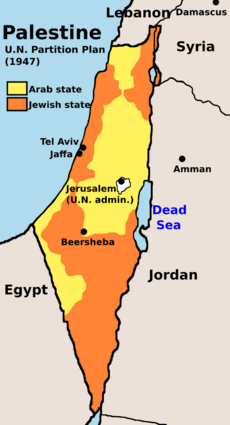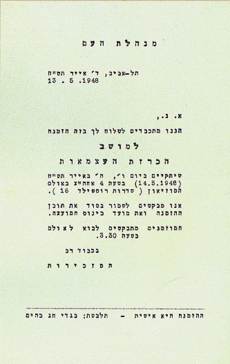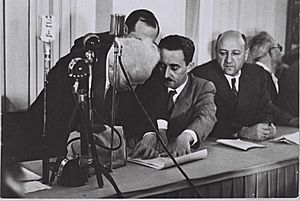Israeli Declaration of Independence facts for kids
Quick facts for kids Declaration of the Establishment of the State of Israel |
|
 |
|
| Created | 14 May 1948 (5 Iyar 5708) |
| Location | Tel Aviv |
| Authors | First Draft: Zvi Berenson Second Draft: Moshe Shertok David Remez Felix Rosenblueth Moshe Shapira Aharon Zisling Third Draft: David Ben-Gurion Yehuda Leib Fishman Aharon Zisling Moshe Shertok |
| Signers | David Ben-Gurion Daniel Auster Yitzhak Ben-Zvi Mordechai Bentov Eliyahu Berligne Fritz Bernstein Rachel Cohen-Kagan Eliyahu Dobkin Yehuda Leib Fishman Wolf Gold Meir Grabovsky Avraham Granovsky Yitzhak Gruenbaum Kalman Kahana Eliezer Kaplan Avraham Katznelson Saadia Kobashi Moshe Kolodny Yitzhak-Meir Levin Meir David Loewenstein Zvi Luria Golda Meyerson Nahum Nir David-Zvi Pinkas Felix Rosenblueth David Remez Berl Repetur Zvi Segal Mordechai Shatner Ben-Zion Sternberg Bechor-Shalom Sheetrit Haim-Moshe Shapira Moshe Shertok Herzl Vardi Meir Vilner Zerach Warhaftig Aharon Zisling |
| Purpose | Declare a Jewish state in Mandatory Palestine shortly before the expiration of the British Mandate. |
The Israeli Declaration of Independence is a very important document. It was officially called the Declaration of the Establishment of the State of Israel. On May 14, 1948, David Ben-Gurion read it aloud. He was a key leader and later became Israel's first Prime Minister of Israel.
This declaration announced that a Jewish state would be created in a land called Eretz Israel. This new country would be known as the State of Israel. It would become a country when the British Mandate ended at midnight that day. Every year, Israel celebrates this day as Independence Day, a national holiday.
Contents
How Israel Became a State
For a long time, many Jewish people dreamed of having their own homeland in Palestine. This idea is called Zionism. In 1917, a British official named Arthur Balfour wrote a letter. In this letter, he said the British government supported the idea of a "national home for the Jewish people" in Palestine. This letter became known as the Balfour Declaration.
After World War I, the United Kingdom took control of Palestine. This was called a "mandate" from the League of Nations. In 1937, a group called the Peel Commission suggested dividing Palestine into an Arab state and a Jewish state. However, this idea was not put into action.
The United Nations Steps In
After World War II, there was a lot of fighting in Palestine. So, the British asked the new United Nations for help. The UN decided to divide Palestine into two parts: an Arab state and a Jewish state. The city of Jerusalem would be a special international zone.
The Jewish people mostly accepted this plan. But many Arab people did not agree with it. On November 29, 1947, the UN voted on the plan. Most countries voted yes, with 33 in favor, 13 against, and 10 not voting. The plan said that the new states would become independent by October 1, 1948.
Writing the Declaration
Many people helped write the Declaration of Independence. The first draft was written by Zvi Berenson, a legal expert. Then, a group of lawyers and leaders worked on it. This group included David Ben-Gurion, Moshe Sharett, and Aharon Zisling. They made sure the final words were just right.
The Big Vote
On May 12, 1948, a group called the Minhelet HaAm (which means "People's Administration") met. They had to decide whether to declare independence or accept a truce (a ceasefire) from the United States.
Six out of ten members voted to declare independence. These included David Ben-Gurion and Moshe Sharett. Four members voted against it, preferring a truce. Chaim Weizmann, who would soon become Israel's first President of Israel, strongly supported the decision to declare independence.
Important Decisions for the Final Wording
The final text of the declaration was approved on May 14, just before the ceremony. There were two main discussions during this process.
Borders of the New State
The declaration did not clearly state the borders of the new country. The original plan was to use the borders from the UN partition plan. But David Ben-Gurion disagreed. He said that the Arabs had not accepted the UN plan and were preparing for war. He believed that if they won the war, Israel might gain more land. So, they decided not to include specific borders in the declaration.

Mentioning Religion
Another big discussion was about including the word "God" in the document. Some religious leaders wanted phrases like "God of Israel" or "the Almighty." However, some members, like Aharon Zisling, were more secular and did not want to include religious terms.
In the end, they used the phrase "Rock of Israel". This phrase could mean God, or it could refer to the land of Israel itself. This was a way for everyone to agree.
Choosing a Name
They also had to pick a name for the new country. Many names were suggested, like Eretz Israel, Judea, and Zion. But "Israel" was chosen by a vote of 6 to 3. Officials also discussed what the country's name would be in Arabic. They chose "Israel" to avoid confusion with a possible Arab state.
The Declaration Ceremony
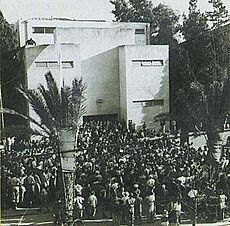
The ceremony was held at the Tel Aviv Museum. It was kept secret because people worried the British might try to stop it. Also, they feared Arab armies might invade sooner than expected. Invitations were sent out on the morning of May 14, asking guests to keep it a secret.
The event started at 4:00 PM. This time was chosen so it would not break the Sabbath. The ceremony was broadcast live on the radio.
The final copy of the declaration was typed just before the ceremony. The person carrying it, Ze'ev Sherf, had trouble finding a ride. He had to flag down a car and convince the driver to take him. A policeman even stopped the car for speeding, but let them go when he heard they were on their way to the declaration! Sherf arrived just in time.
At 4:00 PM, David Ben-Gurion started the ceremony. The 250 guests immediately began singing "Hatikvah", which would become Israel's national anthem. Behind Ben-Gurion hung a picture of Theodor Herzl, who started modern Zionism. There were also two flags, which later became the official flag of Israel.
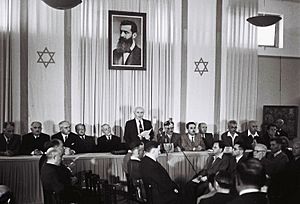
Ben-Gurion read the declaration, which took 16 minutes. He ended by asking everyone to stand and for Rabbi Fishman to say a special blessing.
Who Signed the Declaration?
David Ben-Gurion was the first to sign. All 37 members of the Moetzet HaAm (National Council) were supposed to sign. However, twelve members could not be there. Eleven were stuck in Jerusalem, which was under attack. One was abroad.
The remaining 25 people signed in alphabetical order. Spaces were left for those who were absent. Two women signed the declaration: Golda Meir and Rachel Cohen-Kagan.
Some signers later changed their names to sound more Hebrew. For example, Golda Meir used to be Golda Meyerson. After the last person signed, the audience stood again, and the Israel Philharmonic Orchestra played "Hatikvah." Ben-Gurion then announced, "The State of Israel is established! This meeting is adjourned!"
What Happened Next
The declaration happened during a civil war between Arabs and Jews in Palestine. Right after the declaration, armies from neighboring Arab countries attacked. This started the 1948 Arab–Israeli War.
The fighting continued on and off for over a year. By July 1949, armistice agreements were signed. Israel had kept its independence and even gained more land than the UN plan suggested.
After the declaration, the Moetzet HaAm became the Provisional State Council. This group acted as the government until the first elections in January 1949. Many of the people who signed the declaration became important leaders in Israel. Moshe Sharett and Golda Meir both became Prime Minister. Yitzhak Ben-Zvi became the country's second president.
The United States quickly recognized Israel, just eleven minutes after the declaration. Other countries like Iran, Guatemala, and the Soviet Union also recognized the new state. Israel became a member of the United Nations on May 11, 1949.
In the years after the war, many Jewish people moved to Israel. About 700,000 Jews came to Israel in the first three years. Many of these were survivors of World War II. Also, between 1948 and the 1970s, many Jews left or were forced to leave Arab countries. About 800,000 to 1,000,000 Jews left these countries, with many coming to Israel. At the same time, a large number of Arabs also left, fled, or were expelled from what became Israel.
The Declaration in Israeli Law
The Declaration of Independence says that Israel will be a country based on "freedom, justice and peace." It also promises "complete equality of social and political rights to all its inhabitants irrespective of religion, race or sex."
However, the Israeli Supreme Court has said that the declaration is not a law itself. Instead, it is a set of guiding ideas. In 1994, some of Israel's basic laws were changed to include the spirit of the declaration's principles.
The Original Scroll

When Ben-Gurion read the declaration, he was actually reading from handwritten notes. The artist, Otte Wallish, had not finished the entire scroll yet. He completed the full document in June. The original scroll is now kept in Israel's National Archives.
See also
 In Spanish: Declaración de independencia de Israel para niños
In Spanish: Declaración de independencia de Israel para niños
- Churchill White Paper
- 1929 Palestine riots
- Passfield white paper
- White Paper of 1939
- The Recording of the Israel Declaration of Independence
- Palestinian Declaration of Independence
- Yom Ha'atzmaut
- List of international declarations


